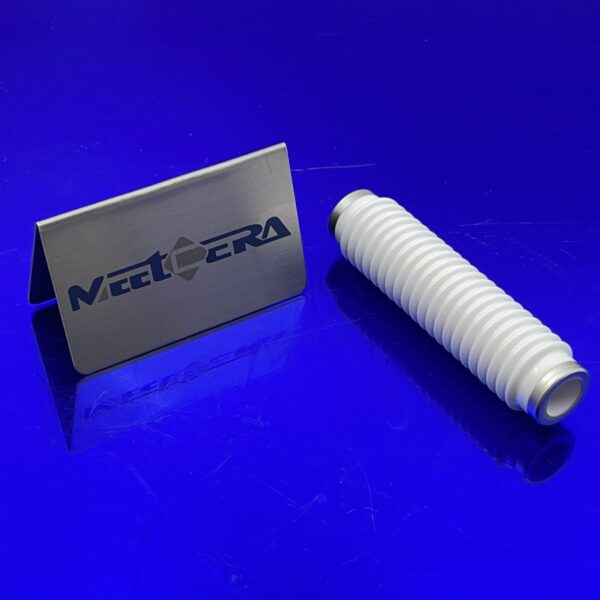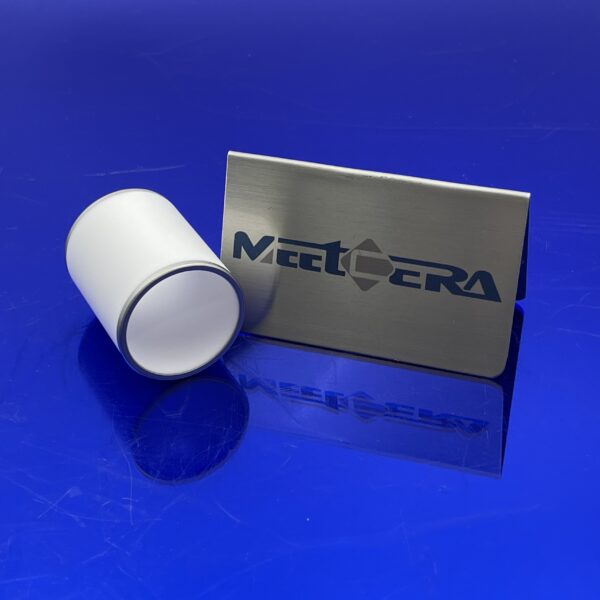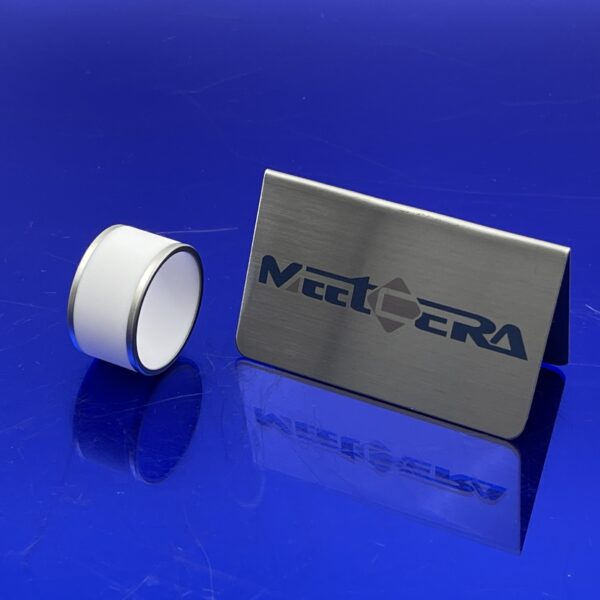What is Metallized Alumina Ceramic?
I spend a lot of time working with technical ceramics. One specific type I deal with often is metallized alumina ceramic1. People ask me what it is and why it matters. Simply put, it is alumina ceramic that has a thin layer of metal added to its surface. But the 'why' is important. It solves some key problems engineers face when building advanced systems.
How joining Ceramic to Metal?
Engineers often need to connect a ceramic component, like an insulator or a structural part, to a metal housing or frame in a reliable way. Standard joining methods for metals do not work on ceramics.
Without a good way to join them, you cannot build complex assemblies that use the benefits of both materials. Joints made with simple adhesives might be weak or fail under temperature changes, vibration, or stress. This means the whole system cannot be built as intended, or it will fail prematurely, leading to equipment breakdown and costly downtime for repair or replacement.
The metallization layer on alumina provides a surface that can be wetted and bonded by braze alloys at high temperatures. When cooled, the braze alloy creates a strong, mechanical, and often hermetic bond between the metallized ceramic and the metal part. This ability to reliably braze allows engineers to combine the insulating and high-temperature properties of alumina with the structural and joining capabilities of metal components, enabling the creation of complex, multi-material assemblies that would otherwise be impossible.
I remember one project where a client needed to attach an alumina insulator inside a metal enclosure. They tried several glues, but they all failed when the temperature changed. Once we used a metallized alumina part and brazed it in place, the problem was solved.
Can metallized ceramics be adapted to sealing harsh environments?
If the feedthrough is not perfectly sealed, the controlled environment is compromised. In a vacuum system, a leak destroys the vacuum. In a pressure system, it leaks the working fluid. In a corrosive environment, outside air or moisture gets in and damages internal parts. Even tiny leaks cause big problems, leading to system failure, loss of process control, and potentially dangerous situations. Traditional insulators often cannot create a reliable, long-term hermetic seal2 when joined to metal.
Metallized alumina, when brazed to metal housings, creates an extremely reliable, hermetic seal. The high temperatures used in brazing, combined with the proper design of the ceramic and metal parts, result in a vacuum-tight joint that can withstand significant pressure differences and thermal cycling. This hermetic sealing capability is critical for applications like vacuum feedthroughs, medical implants, and sensors operating in harsh chemical or pressure environments, ensuring the integrity and safety of the system.
In my experience building vacuum tubes years ago, a perfectly sealed feedthrough was essential. Metallized alumina was the only reliable way to get power into the vacuum envelope without leaks.
Can metallized parts function properly under high-temperature processes3?
Many insulating materials degrade or lose strength at high temperatures. Also, metals and ceramics expand at different rates when heated. If a joint between a standard insulator and metal cannot handle these stresses, it will crack or fail. This failure at high temperature can cause electrical short circuits, loss of support for components, and stop the high-temperature process, leading to expensive downtime and potential damage to the equipment.
Alumina ceramic is known for its ability to withstand very high temperatures. The metallization layer and the braze alloys used are selected to match the thermal expansion of the ceramic and the metal as much as possible, and to withstand the operating temperature. Metallized alumina components can operate continuously at high temperatures where most plastics or glasses would fail, providing stable electrical insulation and mechanical support, and the brazed joints remain strong and reliable despite the heat.
We helped a client improve their high-temperature furnace by replacing outdated insulators that were cracking. Metallized alumina parts brazed into the structure worked perfectly and lasted much longer.
If an electrical fault occurs in an insulated feedthrough, can it result in a short circuit?
If the insulating feedthrough fails electrically, it can cause a short circuit, damaging the power source or sensitive electronics. If it fails mechanically or loses its seal, it compromises the system's environment (vacuum, pressure, etc.). An unreliable feedthrough is a weak point that can lead to unpredictable failures, making the entire device unreliable and potentially unsafe.
Metallized alumina feedthroughs provide a robust solution. The alumina core is an excellent high-voltage insulator. The central conductor passes through it, insulated by the ceramic. The metallization on the outer surface allows the ceramic body to be brazed into a metal flange or housing, creating a strong, hermetic, and electrically isolating barrier. This allows for safe and reliable passage of electrical current or signals through a barrier while maintaining electrical isolation and environmental sealing, essential for critical electrical and electronic systems.
| Feature | Plain Alumina | Metallized Alumina | Benefit |
|---|---|---|---|
| Electrical Insulation | Excellent | Excellent | Blocks electricity flow |
| High Temp Capability | Excellent | Excellent | Works in hot places |
| Chemical Resistance | Excellent | Excellent | Resists harsh chemicals |
| Joining to Metal | Difficult, unreliable | Easy and reliable via brazing | Creates strong, sealed assemblies |
| Hermetic Sealing | Difficult | Possible via brazing | Prevents leaks (vacuum, pressure, gas) |
| Assembly Complexity | Limited | High | Enables complex, multi-material components |
This table summarizes the key difference. Metallization adds the critical ability to join and seal.
Benefits in Real-World Systems
Using metallized alumina ceramic components provides significant benefits. You get systems that are more reliable because the joints do not fail and the insulation holds up. This leads to less maintenance and longer product life. The ability to create hermetic seals protects sensitive components and allows for operation in demanding environments like vacuum or high pressure. This material enables smaller, more powerful designs in electronics by handling heat and voltage effectively. Overall, it allows engineers to build systems that perform better and last longer than they could with traditional materials.
Can It Be Used in Vacuum? Exploring Metallized Alumina for Vacuum Applications
Working with vacuum systems is a critical part of many industries. I have seen engineers struggle to find materials that perform reliably in these environments. A vacuum is not empty space; it is an environment where gas pressure is much lower than outside. This puts special demands on materials. The question "Can it be used in vacuum?" is very important. This article looks at metallized alumina and why it is often a good answer for vacuum needs.
The Vacuum Challenge: What Materials Face
Vacuum systems need materials that do not release gases (outgas) into the vacuum space. They also need materials that gases cannot easily pass through (permeate). Many vacuum processes also involve high temperatures or exposure to plasmas and ions. Materials used here must be stable. They need to maintain their physical and electrical properties. If a material fails in vacuum, it can contaminate the process, lose functionality, or even damage expensive equipment. Selecting the right material is crucial for achieving and maintaining the desired vacuum level and for the success of the process happening inside.
What happens when a material releases trapped gases inside a vacuum chamber?
This increases the pressure inside the chamber. Achieving a high vacuum level becomes difficult or impossible.
Many materials, especially polymers or porous ceramics, hold onto water vapor and other gases. When placed in vacuum, these gases escape slowly over time. Alumina ceramic, particularly high-purity, dense alumina, has a very low surface area and is non-porous. This means it holds very few trapped gases. Therefore, metallized alumina exhibits extremely low outgassing rates, which is essential for reaching and maintaining high or ultra-high vacuum (UHV) levels.
I remember a project where plastic parts were used by mistake in a high vacuum chamber. The vacuum pump ran for hours but could not reach the target pressure because the plastic kept releasing gases. We had to vent the chamber, remove the plastic, and bake it out separately, losing a lot of time.
Can gases pass through the material itself, even if it is not porous?
Yes, some gases can permeate through the bulk of certain materials, especially polymers. This allows atmospheric gases to slowly leak into the vacuum chamber.
Permeation rates for gases through dense ceramics like alumina are extremely low compared to many other materials used in vacuum, like elastomers or certain plastics. The tightly bound atomic structure of alumina forms a strong barrier against gas diffusion. This makes metallized alumina effective at maintaining vacuum integrity over time, preventing leaks from the outside.
In sensitive vacuum processes, even a tiny leak from permeation can ruin a batch of product or interfere with scientific experiments. Having materials that form a reliable barrier is not just good practice; it is necessary for process success.
What happens when materials are exposed to these conditions?
Some vacuum processes involve plasmas or energetic ions, like in semiconductor etching or coating.
Materials can erode or degrade when hit by energetic ions or chemically react with the plasma. This can release particles that contaminate the process.
Alumina is a very hard and chemically stable ceramic. It resists erosion from ion bombardment and is largely inert to many reactive gases used in plasma processes. Metallized alumina components maintain their shape and properties even when exposed to harsh plasma environments, minimizing contamination and extending component life.
I have seen metal parts inside plasma chambers erode quickly, creating metallic dust that ruined the devices being manufactured. Switching to a ceramic material like alumina provided the needed resistance to the plasma.
What challenges does heat present for materials in vacuum?
Many vacuum processes, like brazing, heat treatment, or thin-film deposition, happen at high temperatures.
Materials must maintain their strength and stability at high temperatures without melting, deforming, or releasing large amounts of gas. Some materials become weaker or react at high heat.
Alumina ceramic has a very high melting point and retains its mechanical strength and electrical insulation properties at temperatures far exceeding those possible with most polymers or even many metals. The metallization layer and braze alloys used with alumina are also selected for their high-temperature vacuum compatibility. This allows metallized alumina components to function reliably in high-temperature vacuum furnaces or process chambers.
Designing for high-temperature vacuum is tough because fewer materials can handle the heat. Alumina's ability to stay strong and stable at high temperatures makes it a go-to choice for these applications.
How can engineers do this without creating leaks?
Often, electrical signals or power need to enter a vacuum chamber. You need vacuum feedthroughs that are electrically insulating but also create a hermetic seal where they pass through the chamber wall.
This is where the "metallized" part of metallized alumina is crucial. A metal layer is bonded to the alumina ceramic. This layer allows the ceramic insulator to be brazed to a metal flange or housing. The resulting brazed joint is extremely strong and creates a reliable, hermetic seal that is essential for maintaining vacuum integrity while allowing electrical signals to pass into or out of the chamber.
Making a perfect seal between a ceramic and a metal is hard. Using metallized ceramic specifically designed for brazing solves this problem by creating a permanent, leak-free connection that can withstand temperature changes and mechanical stress.
Does being in a vacuum affect a material's physical strength or dimensions?
While the vacuum itself does not usually weaken materials significantly, the high temperatures or stresses often associated with vacuum processes can. Materials must remain dimensionally stable.
Alumina ceramic is a very hard and mechanically strong material. It has a low coefficient of thermal expansion compared to many metals, meaning its size changes less with temperature fluctuations. This dimensional stability is important for precise assemblies in vacuum. The brazed metallization provides a strong mechanical connection that holds up under vibration or stress.
Metallized Alumina: Why It Works in Vacuum
Bringing it all together, metallized alumina is well-suited for vacuum applications because its fundamental properties address the key challenges. The high purity and density of alumina mean extremely low outgassing and permeation. Its chemical inertness provides resistance to plasma and process gases. Its high strength and thermal stability allow it to operate in demanding high-temperature vacuum environments. The added metallization layer enables the creation of strong, hermetic seals through brazing, vital for vacuum feedthroughs and sealed assemblies. These combined features make it a reliable choice.
| Vacuum Challenge | Metallized Alumina Property | Direct Benefit in Vacuum |
|---|---|---|
| Outgassing | Low surface area, Non-porous | Helps achieve and maintain high vacuum levels |
| Gas Permeation | Dense, Tightly bound structure | Forms a strong barrier against gas leaks |
| Plasma/Ion Exposure | Hard, Chemically Inert | Resists erosion and contamination in harsh processes |
| High Temperature | High melting point, Stable structure | Functions reliably in hot vacuum environments |
| Electrical Connections | Allows Hermetic Brazing | Enables reliable, leak-free electrical feedthroughs |
| Mechanical Stability | Hard, Strong, Dimensionally Stable | Maintains integrity under thermal/mechanical stress |
This table clearly shows how the material properties map to solving vacuum-specific problems. It provides a concise summary of its advantages.
Benefits of Using Metallized Alumina in Vacuum
Choosing metallized alumina for vacuum components brings several benefits. You can achieve better vacuum levels faster and maintain them more easily. This leads to higher process yields and more reliable system performance, especially in sensitive applications like semiconductor manufacturing or scientific research. Components last longer because they resist degradation from heat, plasma, and outgassing. The ability to create reliable, hermetic electrical feedthroughs simplifies system design and improves safety. Overall, using metallized alumina contributes to more robust, efficient, and reliable vacuum systems.
Think about electron microscopes or particle accelerators. These require very high vacuum to function correctly. Components inside cannot release gases or degrade. Metallized alumina parts are often used in such instruments because they provide the necessary vacuum compatibility and electrical insulation.
Conclusion
Metallized alumina ceramic is more than just a material; it is a solution to fundamental engineering challenges. It takes the already excellent properties of alumina – its electrical insulation, high-temperature resistance, and mechanical strength – and adds the crucial ability to be reliably joined and hermetically sealed to metal parts through metallization and brazing. This capability solves critical problems related to creating robust connections, sealing demanding environments, building high-temperature assemblies, and designing reliable electrical feedthroughs. By using metallized alumina, engineers can design and build more advanced, reliable, and higher-performing systems across many industries.
-
Explore how metallized alumina ceramic is revolutionizing engineering applications with its unique properties and benefits. ↩
-
Learn about the importance of hermetic seals in vacuum systems and how they ensure reliability and safety. ↩
-
Discover the best materials for high-temperature applications and how they can improve system performance and reliability. ↩








No comment